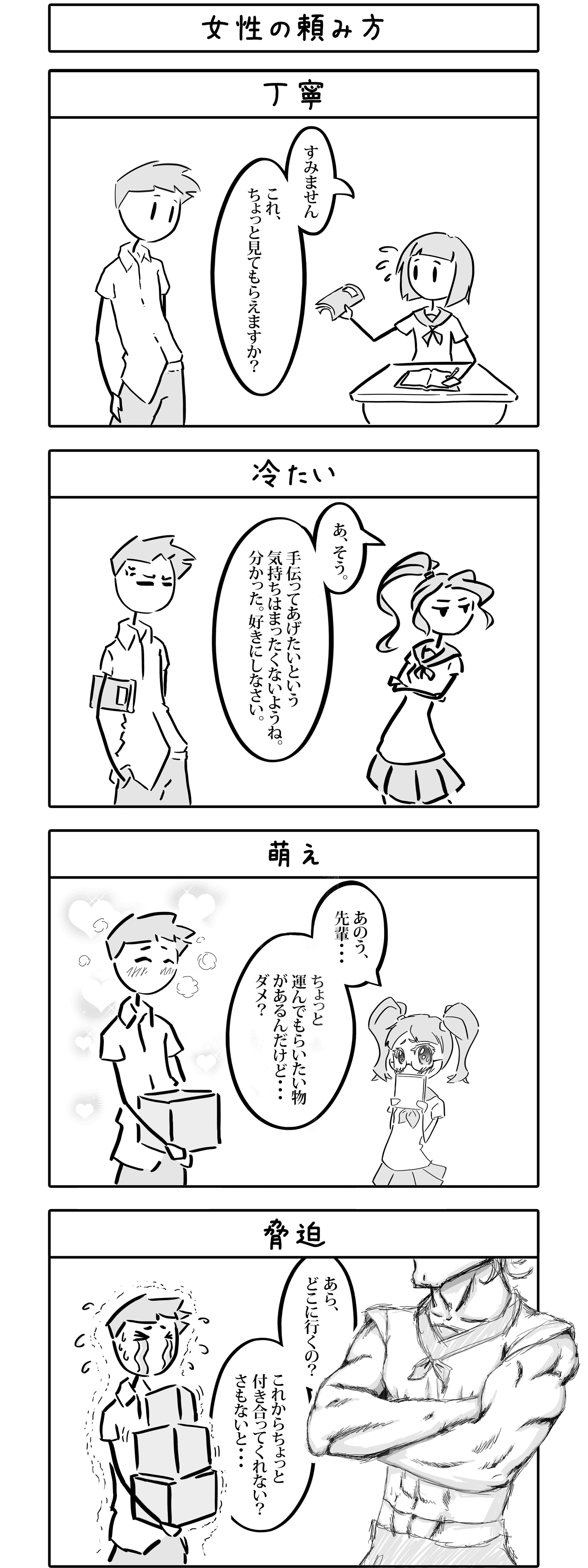In this section, we will learn the command form, which as the name suggests, is used to issue commands to others.
Using 「~なさい」 for polite command
「~なさい」 is the “polite” way to tell others what to do. It’s used by attaching 「なさい」 to the verb stem.
It’s polite grammatically but it doesn’t change the fact that you’re ordering others around, which is not very polite generally. It’s most commonly used by parents or other authority figures toward children.
Example
- 早く出かける準備をしなさい。
Hurry up and prepare to go out. - ちゃんと約束時間を守りなさいよ。
Please properly keep the promised time.
In casual speech, the 「~なさい」 can also be shortened to just 「な」
Example
- 早く出かける準備をしな。
Hurry up and prepare to go out. - ちゃんと約束時間を守りなよ。
Please properly keep the promised time.
Comic 15 – 女性の頼み方

- 女性 【じょせい】 – woman; female
- 頼む 【たの・む】(u-verb) – to make a request
- 丁寧 【てい・ねい】(na-adj, n) polite
- すみません – sorry (polite)
- これ – this
- ちょっと – a little (casual)
- 見る 【み・る】(ru-verb) – to see
- 冷たい 【つめ・たい】(i-verb) – cold (to the touch); coldhearted
- そう – so
- 手伝う 【て・つだ・う】(u-verb) – to help
- あげる (ru-verb) – to give; to raise
- 気持ち 【き・もち】 – feeling, mood
- まったく- at all, entirely
- ある (u-verb) – to exist (inanimate)
- 分かる 【わ・かる】 (u-verb) – to understand
- 好き 【す・き】 (na-adj) – likable
- する (exception) – to do
- 萌え 【もえ】budding, having a crush
- あのう/あの – say; well; errr
- 先輩 【せん・ぱい】- senior (at work or school)
- 運ぶ 【はこ・ぶ】(u-verb) – to carry, to transport
- もらう (u-verb) – to receive
- 物 【もの】 – thing
- 駄目 【だ・め】 (na-adj) – no good
- 脅迫 【きょう・はく】- threat, coercion
- あら – oh my
- どこ – where
- 行く 【い・く】 – to go
- 付き合う 【つ・き・あ・う】(u-verb) – to keep company with, to go out with
- くれる (ru-verb) – to give
- さもないと – otherwise, or else
丁寧
すみません。これ、ちょっと見てもらえますか?
冷たい
あ、そう。手伝ってあげたいという気持ちはまったくないようね。分かった。好きにしなさい。
萌え
あのう、先輩、運んでもらいたい物があるんですけど・・・ ダメ?
脅迫
あら、どこに行くの?これからちょっと付き合ってくれない?さもないと・・・
Toggle Translations
Polite
Sorry. Can you look at this a bit?
Threatening
I see. Seems like you have absolutely no feeling of wanting to help. (I) got it. Go ahead and do as (you) please.
Moe
Umm… senpai. There’s something I want you to move but… is it bad?
Threatening
Oh my, where (are you) going? Can (you) accompany (me) for a bit, or else…
Wanting others to do something
We can use the i-adjective 「欲しい」, which means “desired” or “wanted” with verbs to say you want somebody to do something. This is done by first conjugating the verb to the te-form, then attaching 「欲しい」(or ほしい) to the end of the verb. The result remains an i-adjective.
Examples
- 郵便局に行って欲しいんだけど、大丈夫?
(I) want (you) to go to (the) post office but (is it) ok? - 言っていることがいまいち分からないから、何をしてほしいのかはっきり教えてよ。
(I) don’t really understand what (you are) saying so please tell me what (you) want (me) to do clearly.
Command Form
This command form is quite rude so you should use it with caution (if at all). As we learned just in this chapter, there are many other more polite ways to make a request.
- For ru-verbs: Replace the last 「る」 with 「ろ」
Example: 食べる+ ろ = 食べろ - For u-verbs: Replace the last u-vowel sound with the e-vowel equivalent
Example: 買う+ え = 買え - Exceptions:
- する → しろ
- くる → こい
- くれる → くれ (exception for this conjugation only, not an exception verb)
Negative Command
In order to command others to not do an action, simply attach 「な」 to the end of the verb.
Examples
- 秘密だから、誰にも言うなよ。
(It’s a) secret so don’t tell anybody. - 余計なことをするな。
Don’t do something unnecessary.
Do NOT confuse this negative command with the shortened form of 「~なさい」 we just learned. The latter is using the stem of the verb while the negative command uses just the dictionary form.
- これを食べな。
Eat this. - これを食べるな。
Don’t eat this.
- ここに座りな。
Sit here. - ここに座るな。
Don’t sit here.